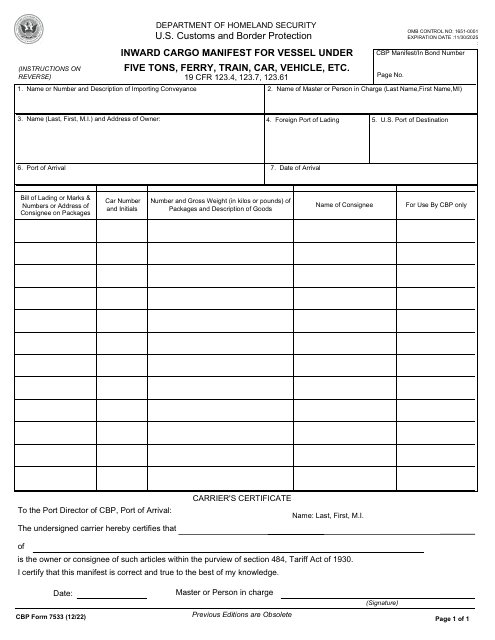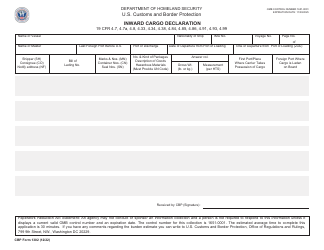CBP Form 7533 Inward Cargo Manifest for Vessel Under Five Tons, Ferry, Train, Car, Vehicle, Etc.
What Is CBP Form 7533?
CBP Form 7533, Inward Cargo Manifest for Vessel Under Five Tons, Ferry, Train, Car, Vehicle, etc. , is used to provide detailed information on the cargo for the use of Customs and Border Protection (CBP) and other officials. Additionally, it serves as a legal instrument that focuses on and documents ownership and describes the physical aspects of the cargo. Manifests are required and needs for various purposes including cargo compatibility checks, load planning, cargo staging, and loading/unloading, customs clearance (import and export), and the operation of the conveyance en route.
Alternate Names:
- CBP Inward Cargo Manifest;
- Entry Manifest.
The latest version of the form was released on December 1, 2022 . A CBP Form 7533 fillable version is available for download and digital filing below.
CBP Form 7523, Entry and Manifest of Merchandise Free of Duty, Carriers Certificate and Release, is a related form used for the goods to clear through the CBP. It lists the importing conveyance for smaller vessels (under five tons) including ferries, cars, trains, and other small vehicles and shipments that consist of conditionally or unconditionally duty-free merchandise that does not exceed $2,500 in value.
CBP Form 7533 Instructions
It is necessary to insert the word "various" if more than one foreign port of lading is mentioned and there are multiple shipments. Indicate the individual ports of lading naming them immediately below the description of the goods in the third column. The form may be presented in duplicate and used as an entry when a shipment does not exceed $2,500 in value, is unconditionally free of duty, is not subject to internal revenue tax or quota, and arrives otherwise than by sea.
The manifest must be presented to the customs officer when the report of the arrival is made. It has to be filed in the original only.
How to Fill Out CBP Form 7533?
The Entry Manifest (CBP Form 7533) instructions are as follows:
-
Write down the CBP manifest/in bond (applicable for goods stored in a bonded warehouse) number.
-
Enter the name or the number and the description of the importing conveyance - the year, the model, and the license plate of the importing conveyance.
-
Indicate the full name of the master or person in charge (usually the driver of the vehicle). State the full name and the address of the owner. It may be the address of the agency or the trucking company.
-
Identify the foreign port of lading - the province where the shipments were loaded. Write down the U.S. port of destination the city and the state the shipment is destined to.
-
State the port of arrival and the date of arrival - the date you enter the USA.
-
Record the information on each of your shipments. One entry has to be made for each shipment conveyed. Describe the cargo in four columns:
- Bill of lading/the marks and numbers/the address of the consignee written on the packages;
- Car number and the initials;
- Number and gross weight (in kilos or pounds) of the packages and the complete description of the goods;
- Name of the consignee.
-
The carrier must certify the ownership of the articles, sign the form, and write down the actual date. If a customs broker is used, the correct broker name must be listed as the owner of the consignee.






